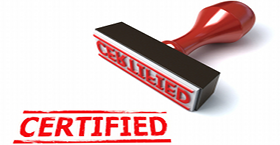
All You Need to Know About Certifications
Certification is a review process designed to ensure that a small business is actually owned, controlled, and operated by the applicants. Most certifications are granted for Minority or Women owned businesses, Small Disadvantaged Businesses, and Under-utilized businesses. Certification agencies implement the processes for government and private sector entities and ensure that only firms that meet the eligibility criteria of the individual programs are properly certified. The fundamentals of each certification is explained below.

Minority Owned Business (MBE)
A minority-owned business is a for-profit enterprise, regardless of size, physically located in the United States or its trust territories, which is owned, operated and controlled by minority group members.
Ownership by minority individuals means the business is at least 51% owned by such individuals or, in the case of a publicly-owned business, at least 51% of the stock is owned by one or more such individuals. Further, the management and daily operations are controlled by those minority group members.
Women Owned Business (WBE)
To become certified as a woman owned business, businesses must show:
- All prospective members must provide clear and documented evidence that at least 51% or more is women-owned, managed, and controlled.
- The business must be open for at least six months.
- The business owner must be a U.S. citizen or legal resident alien.
- Evidence must indicate that The contribution of capital and/or expertise by the woman business owner is real and substantial and in proportion to the interest owned.
- Evidence must indicate that The woman business owner must direct or cause the direction of management, policy, fiscal, and operational matters.
- Evidence must indicate that The woman business owner shall have the ability to perform in the area of specialty or expertise without reliance on either the finances or resources of a firm that is not owned by a woman.
Disadvantaged Business Enterprises (DBE)
To qualify as a DBE, the business must be owned and controlled by one or more socially and economically disadvantaged persons as defined by DBE Regulation 49 CFR Parts 23 and 26. The presumption of disadvantage is refutable. Businesses must show:
- Minimum 51% ownership, control, and expertise of the individual(s)
- Control of the daily management and operations of the individual(s)
- The business’ size as measured by average annual gross receipts over the most recent three years must be under the specified dollar amounts. These size standards are set according to the business’ North American Industry Classification System (NAICS) code. Depending on the industry, these limits can range from $2.5 million averaged per year to $33.5 million averaged per year.
- DBE regulations require all owner applicants to complete a Personal Financial Statement. The NET WORTH must be less than 1.3 million.

Who Qualifies?
- Asian-Indian A U.S. citizen whose origins are from India, Pakistan and Bangladesh
- Asian-Pacific A U.S. citizen whose origins are from Japan, China, Indonesia, Malaysia, Taiwan, Korea, Vietnam, Laos, Cambodia, the Philippines, Thailand, Samoa, Guam, the U.S. Trust Territories of the Pacific or the Northern Marianas.
- African American A U.S. citizen having origins in any of the Black racial groups of Africa.
- Hispanic A U.S. citizen of true-born Hispanic heritage, from any of the Spanish-speaking areas of the following regions: Mexico, Central America, South America and the Caribbean Basin only. Brazilians shall be listed under Hispanic designation for review and certification purposes.
- Native American A person who is an American Indian, Eskimo, Aleut or Native Hawaiian, and regarded as such by the community of which the person claims to be a part
SBA's Definition of Small Business
The SBA defines a small business concern as one that is independently owned and operated, is organized for profit, and is not dominant in its field. Depending on the industry, size standard eligibility is based on the average number of employees for the preceding twelve months or on sales volume averaged over a three-year period. Examples of SBA general size standards include the following:
- Manufacturing: Maximum number of employees may range from 500 to 1500, depending on the type of product manufactured;
- Wholesaling: Maximum number of employees may range from 100 to 500 depending on the particular product being provided;
- Services: Annual receipts may not exceed $2.5 to $21.5 million, depending on the particular service being provided;
- Transportation: Annual receipts may not exceed $25.5.
- General and Heavy Construction: General construction annual receipts may not exceed $14.0 to $33.5 million, depending on the type of construction;
- Land Subdivision: Annual receipts may not exceed $7 million;
- Agriculture: Annual receipts may not exceed $0.5 to $9.0 million, depending on the agricultural product.